Vieste: territory, culture and curiosity
Updated at: 20-09-2024
How this content can help you:
- The unique geographical features of Vieste, with its three bays and two promontories.
- The most beautiful beaches of Vieste, such as Pizzomunno Beach and San Lorenzo Bay.
- The historical and cultural sites to visit, including the Swabian Castle and the Cathedral of Santa Maria Assunta.
- The romantic legend of the Pizzomunno monolith and local traditions.
- The activities to do in Vieste, such as exploring the sea caves and trekking in the Umbra Forest.

Why is Vieste famous?
Vieste is famous for the Pizzomunno monolith, an impressive 25-meter-high limestone formation located on Castello Beach. Enshrouded in the legend of a tragic love between the fisherman Pizzomunno and Cristalda, abducted by sirens, this sea stack draws visitors for its romantic story and natural beauty. The beach, known for its fine sand and crystal-clear waters, is ideal for relaxation, landscape photography, and romance lovers, making Pizzomunno a distinctive landmark of Vieste.
Vieste is located on the Gargano promontory, a rocky peninsula overlooking the Adriatic Sea. It is characterized by a unique geographical formation, with three bays separated by two distinct promontories: Punta di San Francesco and Punta di Santa Croce.
Punta di San Francesco, facing east, hosts the medieval historic center of Vieste. This area is a charming labyrinth of ancient, irregular alleys adorned with white houses and characteristic staircases. Among the main attractions of Punta di San Francesco are the Cathedral of Santa Maria Assunta, the Swabian Castle, and various ancient churches that dot the quarter.
Punta di Santa Croce is located in the flatter part of the peninsula and hosts the port of Vieste, an important infrastructure for tourism and commerce.
From the port, various boat excursions depart, allowing visitors to explore the spectacular Gargano coast and its suggestive sea caves. Additionally, it is possible to take the ferry to the Tremiti Islands, an archipelago known for its crystal-clear waters and pristine landscapes.
The three bays that characterize the Vieste peninsula are equally fascinating.
Baia di Marina Piccola, located near the historic center, is a small cove characterized by calm, transparent waters, ideal for a romantic stroll or a moment of relaxation.
Baia di San Lorenzo is known for its long golden sandy beach and is one of the most frequented bays by tourists, equipped with numerous beach establishments offering various water activities.
Finally, Baia di Pizzomunno, dominated by the famous white limestone monolith, is one of Vieste's symbols. Pizzomunno Beach is one of the most beautiful and fascinating in the area, with fine sand and crystal-clear waters.
How to Reach Vieste

- By Car: From the north, take the A14 highway (Bologna-Taranto) and exit at Poggio Imperiale, then follow the signs to Gargano and Vieste. From the south, also take the A14 with the Foggia exit, continuing on the SS 89 to Vieste.
- By Train: The nearest railway station is Foggia. From there, you can take a bus or rent a car to reach Vieste.
- By Plane: The nearest airports are Bari (Karol Wojtyla) and Pescara (Abruzzo Airport). From both airports, you can continue by car or bus to Vieste.
- By Bus: There are bus services that connect Vieste with various Italian cities, especially during the tourist season.
What Are the Most Beautiful Beaches in Vieste?
Spiaggia di Pizzomunno

This is perhaps the most iconic beach in Vieste. The beach is dominated by the 25-meter-high white limestone monolith known as Pizzomunno, which gives it its name and represents one of Vieste's most recognizable symbols. The beach stretches for about 3 kilometers of golden sand, offering a picturesque and fascinating environment. The water is crystal clear, ideal for swimming and water sports.
Equipped Beaches at Pizzomunno: Costs and Hours
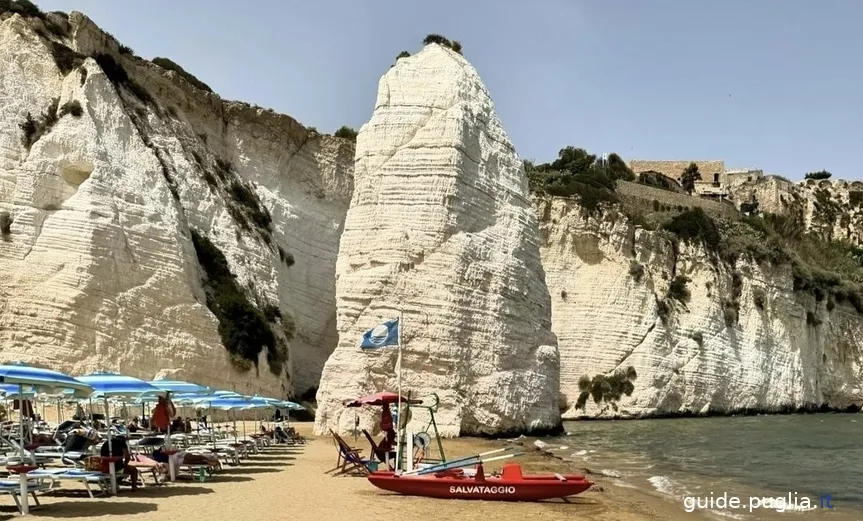
The costs for renting an umbrella and two sunbeds vary depending on the season and the location on the beach. Generally, in high season (July and August), prices can range from 20 to 30 euros per day.
Some beach clubs offer weekly packages or discounts for advance bookings. The opening hours of the beach establishments usually go from 8:00 AM to 7:00 PM, with some structures extending the hours during special events or evenings.
Baia di San Lorenzo
Baia di San Lorenzo is one of the most beautiful and popular beaches in Vieste, located about 3 kilometers north of the historic center of the city. The bay is known for its long stretch of golden sand and clear, shallow waters, making it particularly suitable for families with children. The beach is surrounded by lush Mediterranean vegetation, creating a fascinating and relaxing natural environment.
Baia di San Lorenzo is renowned for its intact natural environment. The beach is surrounded by a pine forest and typical Mediterranean vegetation, offering natural shaded areas ideal for relaxing during hot days.
Services Offered
Baia di San Lorenzo is well-equipped with various services for bathers, including:
- Beach Clubs: The beach has numerous beach clubs offering umbrella and sunbed rentals, bars, restaurants, toilets, and showers.
- Recreational Activities: The establishments offer a range of recreational activities, including water sports such as windsurfing and paddleboarding. There are also play areas for children and beach volleyball courts.
- Parking: Ample parking is available near the beach, making access easy for those arriving by car.
Spiaggia del Castello
The Spiaggia del Castello, also known as Spiaggia della Scialara, is one of the most famous and frequented beaches in Vieste. It extends for about 3 kilometers south of the historic center, along Lungomare Enrico Mattei, and is characterized by fine golden sand. The beach is named after the nearby Swabian Castle, which dominates the city from atop a rocky promontory.
The view from Spiaggia del Castello is breathtaking, with the Swabian Castle offering a spectacular vista over the beach and the sea. The water is crystal clear, and the sandy seabed slopes gently, making it ideal for families with children and those who love long swims.
The calm, clean sea is perfect for swimming and water sports such as paddleboarding and windsurfing.
Events and Themed Evenings
Many beach establishments on Spiaggia del Castello regularly organize events and themed evenings to entertain visitors. These activities range from live music parties to group dances and DJ sets.
During the summer, it is common to find karaoke nights, themed dinners, and animation shows for adults and children. For example, Lido Castello is known for its evenings with music and group dances, creating a lively and fun atmosphere for all participants. Other beach clubs organize special events such as open-air cinema, concerts, and cabaret shows.
These events are highly appreciated by both tourists and locals, offering a unique opportunity to enjoy the beach even after sunset.
Baia di San Felice

Baia di San Felice is located north of Vieste. This bay is famous for the picturesque natural rock arch overlooking the sea, called Arco di San Felice. The Arco di San Felice is the focal point of the bay and represents one of the most photographed natural formations in the region.
The beach is small but very scenic, with clear waters and an intact natural environment, with seabeds rich in marine flora and fauna.
This bay is famous for its suggestive natural beauty. The beach is of fine golden sand, surrounded by high limestone cliffs that offer a breathtaking panorama and an almost magical atmosphere.
Accessibility
Baia di San Felice is accessible via a path starting from the main road. It is a relatively easy hike that leads directly to the beach, making it accessible to almost everyone. Despite its popularity, the bay maintains a sense of tranquility and is never too crowded, offering a more reserved experience compared to other more commercial beaches of the Gargano.
Services
The services in Baia di San Felice are relatively limited compared to larger beaches. This helps maintain the natural environment intact. However, during the summer season, small kiosks provide essential services such as umbrella and sunbed rentals and light refreshments.
Spiaggia di Cala della Pergola

Spiaggia di Cala della Pergola is a small and enchanting cove located north of Vieste, in the heart of the Gargano National Park. This beach is less known compared to others in the area, making it a true hidden gem, perfect for those seeking tranquility away from the crowds.
Cala della Pergola is surrounded by rocky cliffs and lush vegetation, creating an isolated and picturesque environment. The beach is mainly composed of pebbles and coarse sand, and its waters are incredibly clear and blue, ideal for swimming and snorkeling.
Accessibility
The beach is reachable via a steep path starting from the main road. It is not the best option for those with walking difficulties or families with strollers. However, the path offers breathtaking panoramic views of the sea and coast, making the descent to the beach an enjoyable adventure for nature lovers. Access to the sea can be a bit challenging due to the pebbles, so it is advisable to bring suitable shoes.
Services
Being a more isolated and less developed beach, Cala della Pergola offers few services. There are no beach establishments or restaurants directly on the beach, which helps maintain its natural and unspoiled appearance. Visitors are therefore encouraged to bring everything they need for the day, including water, food, and beach equipment.
What to See in Vieste?
- Historic Center
- Cathedral of Santa Maria Assunta
- Swabian Castle
- Port of Vieste
- Civic Archaeological Museum
- Sanctuary of Santa Maria di Merino
- Arco di San Felice
- Pizzomunno
- Trabucco
Vieste, with its rich historical and natural heritage, offers a wide range of attractions for visitors. Here is an overview of the main things to see in Vieste:
Historic Center
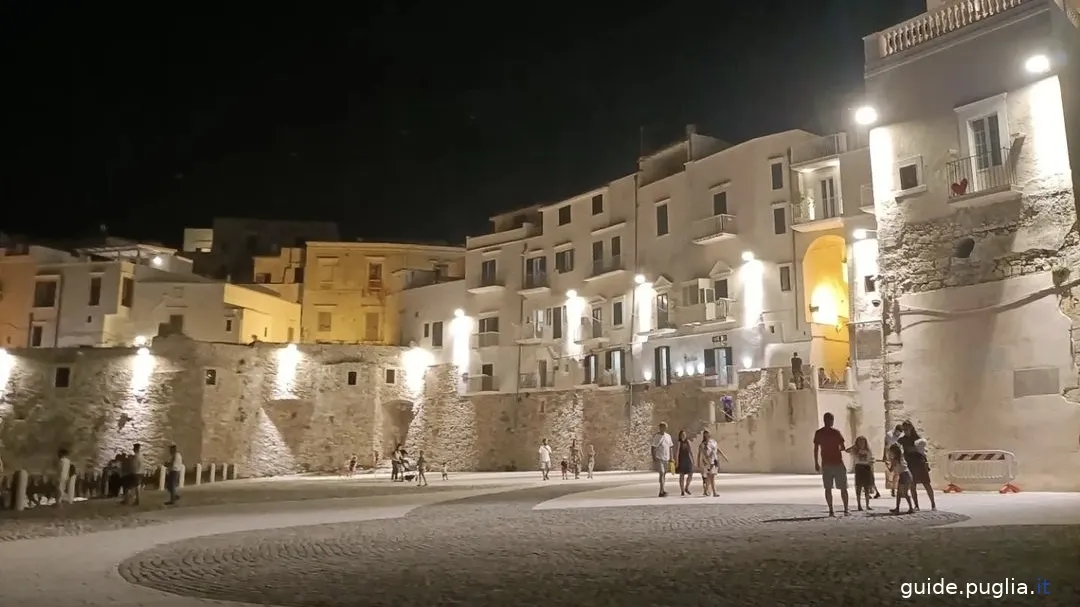
This part of the city is characterized by a particular charm, with its narrow cobbled streets, often lined with traditional white houses facing each other, ancient arches, and a labyrinthine layout that reflects the typical medieval style.
These features were originally designed to protect the inhabitants from strong winds and pirate attacks. The historic center is also the commercial heart of the city, with numerous craft shops, boutiques, and markets where residents and tourists can buy typical products and souvenirs.

Throughout the year, the historic center of Vieste comes alive with various cultural events, festivals, and religious celebrations, including processions, concerts, and outdoor theatrical performances.
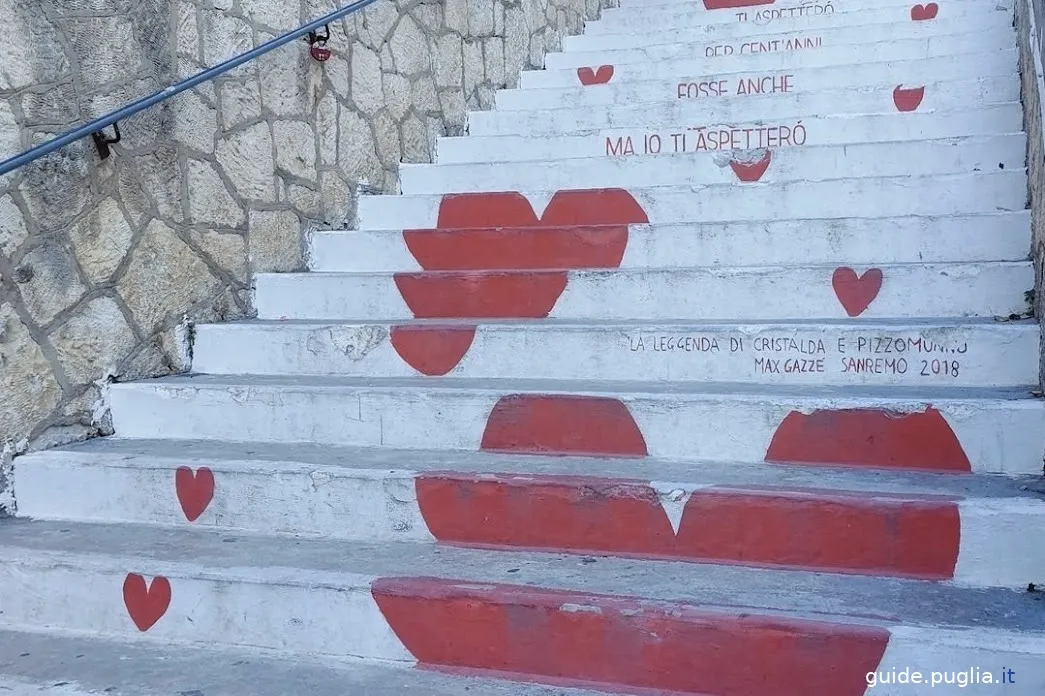
Cathedral of Santa Maria Assunta
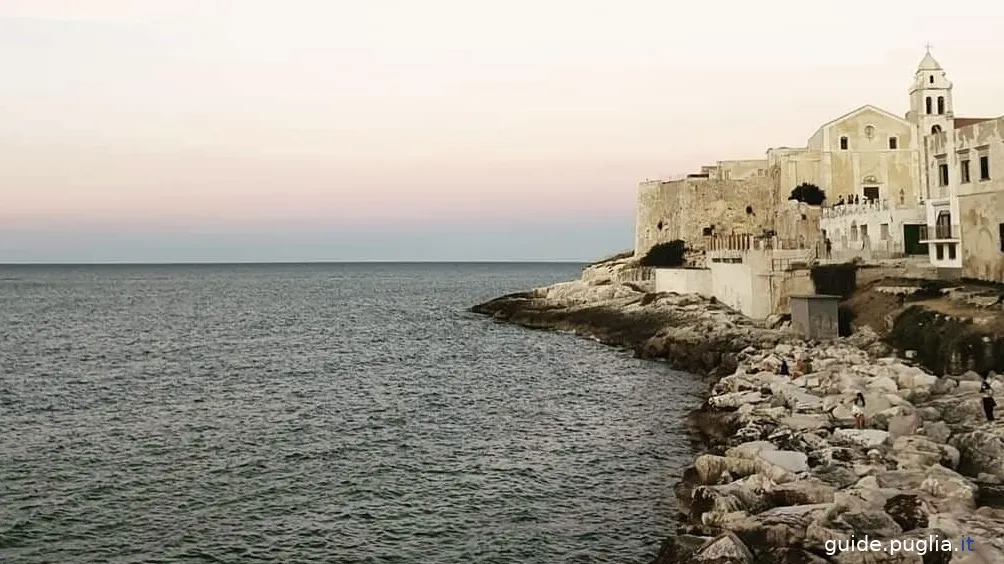
The Cathedral of Santa Maria Assunta, located in the heart of Vieste's historic center, is one of the city's most significant religious buildings. Dating back to the 11th century, this cathedral was built in the Apulian Romanesque style, a common architectural form in many churches in the Gargano region during the Middle Ages.
The church has undergone several modifications over the centuries, including restorations and additions that have altered part of its original structure. The facade of the cathedral is characterized by an imposing rose window that illuminates the interior and a decorated portal that testifies to the skill of the craftsmen of the time.
Inside, the cathedral features a single nave with side chapels housing various sacred artworks, including statues and paintings that enrich its artistic heritage.
Visits and Activities
The cathedral is open to visitors and represents a must-see for anyone interested in medieval history and architecture. In addition to regular religious functions, the Cathedral of Santa Maria Assunta hosts cultural events, sacred music concerts, and exhibitions that help enhance its role in the community.
Conservation
The care and conservation of this historic monument are of great importance to the Vieste community. Ongoing efforts to preserve the cathedral help ensure it remains a place of beauty and inspiration for future generations.
Accessibility
The cathedral is open to visitors every day from 8:30 AM to 7:00 PM, and entry is free, allowing everyone to admire this jewel of Vieste's religious and cultural heritage without barriers.
Swabian Castle

The Swabian Castle of Vieste, located on a rocky promontory overlooking the city and the surrounding sea, is a fortress rich in history and charm. Built in the 11th century, it has undergone various modifications and expansions over the centuries, becoming an iconic symbol of Vieste. Originally built for defensive purposes, the Swabian Castle played a crucial role in protecting the city against pirate attacks and enemy powers. Over the centuries, the castle was expanded and fortified, especially during the Norman period and later under the reign of Frederick II of Swabia, from whom it takes its name.
Architecture
The castle features a massive structure with robust walls and watchtowers. Its architecture reflects the various construction phases and the different styles adopted over the centuries. The castle walls offer spectacular views of the Gargano coast and the historic center of Vieste.
Visits
The castle represents a must-see for visitors to Vieste. The towers and walls of the castle also offer ideal vantage points for admiring the city and the maritime landscape. Being a military headquarters, the Swabian Castle of Vieste is not regularly open to the public. It is accessible only during special events, and there is no specific information on entry costs or regular opening hours. The accessible areas during these events can vary, but generally include the courtyard and some rooms hosting temporary exhibitions. Guided tours are available and offer an in-depth immersion into the castle's history and architectural evolution.
Port of Vieste
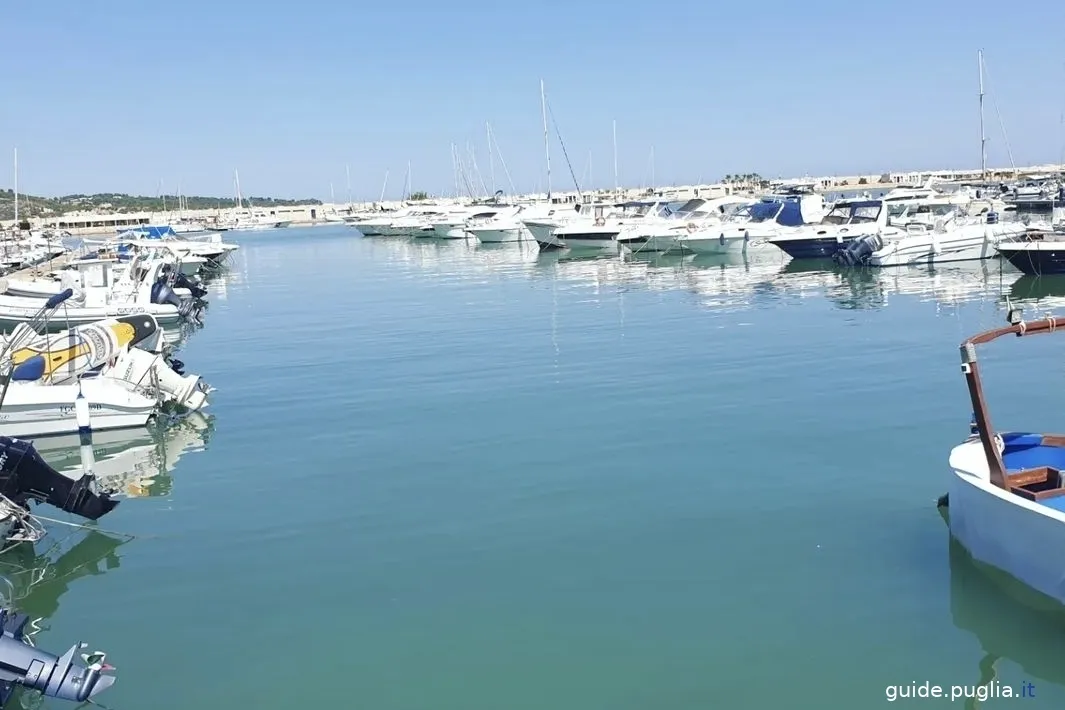
The Port of Vieste is a vital hub for both fishing and tourism in the region. This picturesque port serves as a starting point for boat excursions to the famous sea caves and the Tremiti Islands, also offering ferry services and boat rentals.
Its central location relative to the city allows easy access to local beaches and the historic center, making it a lively area ideal for strolling and enjoying the bustling maritime atmosphere. During the summer, the port becomes a center of activity, with markets and restaurants offering fresh seafood products.
The port is also the starting point for numerous excursions to the Gargano National Park, making it a crucial hub for exploring the region's natural beauty.
Civic Archaeological Museum
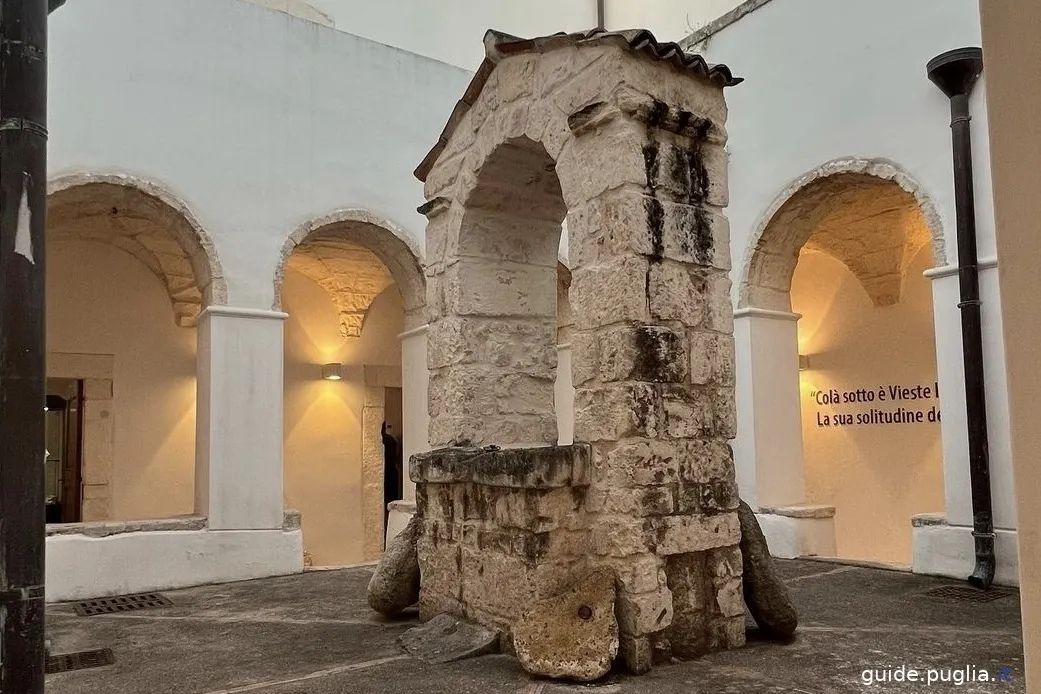
The Civic Archaeological Museum "Michele Petrone" in Vieste is a site of great historical and cultural value that deserves a detailed visit.
Located in the convent complex of the Beata Vergine degli Angeli, the museum offers a deep immersion into the archaeological history of Vieste and its territory, with artifacts covering different eras, from prehistory to the Hellenistic-Roman age.
Museum Collections
The museum's collections are extensive and varied, including:
- Messapic Inscriptions: Texts in ancient Greek offering a glimpse into the local language and religious practices.
- Amphorae and Anchors: Symbols of Vieste's long maritime history, these objects illustrate ancient trade and navigation activities.
- Neolithic Artifacts: Items from the Defensola flint mine, including tools used by Neolithic miners such as ceramic vases, picks, and oil lamps.
Special Exhibitions
- Semichamber Tomb: Discovered in 2006 under the courtyard of the Town Hall, this tomb revealed a rich funerary set, providing valuable details about the lives and customs of Vieste's ancient inhabitants.
- Daunian Stele: These funeral steles, with inscriptions and depictions, are a distinctive expression of Daunian civilization, highlighting aspects of daily life and religious practices.
Hours and Services
- Winter Hours: Monday to Friday from 9:00 AM to 7:00 PM.
- Summer Hours: Monday to Friday from 5:00 PM to 11:00 PM.
- Closed: Saturday and Sunday.
- Tickets: Admission to the museum is paid, with the possibility of booking guided tours to deepen the understanding of the artifacts.
Sanctuary of Santa Maria di Merino
The Sanctuary of Santa Maria di Merino is located about 7 kilometers south of Vieste, on the Gargano promontory. The sanctuary is dedicated to Santa Maria di Merino, venerated as the protector of the people of Vieste and fishermen.
Tradition tells that the icon of the Madonna was found by local shepherds in 1008 on a nearby beach, after being brought in by the sea. The current building of the sanctuary dates back to the 17th century, but documents attest to the existence of a church on that site since the 12th century.
Architecture
The architecture of the sanctuary is simple and reflects the typical style of rural Apulian churches, with a modest facade and an interior containing a venerated image of the Virgin Mary. Despite its simplicity, the place exudes a strong spirituality and represents an important religious landmark for the local community.
Festivities and Celebrations
The feast of Santa Maria di Merino, held annually on May 9, attracts numerous faithful and tourists. The celebrations include a procession from the center of Vieste to the sanctuary, solemn masses, and cultural and recreational activities that last throughout the day.
Visits
The sanctuary is accessible to visitors year-round and represents a significant stop for those interested in the religious and cultural history of Vieste and the Gargano. Its location also offers panoramic views of the surrounding landscape, making it an ideal place for moments of reflection and tranquility.
Arco di San Felice
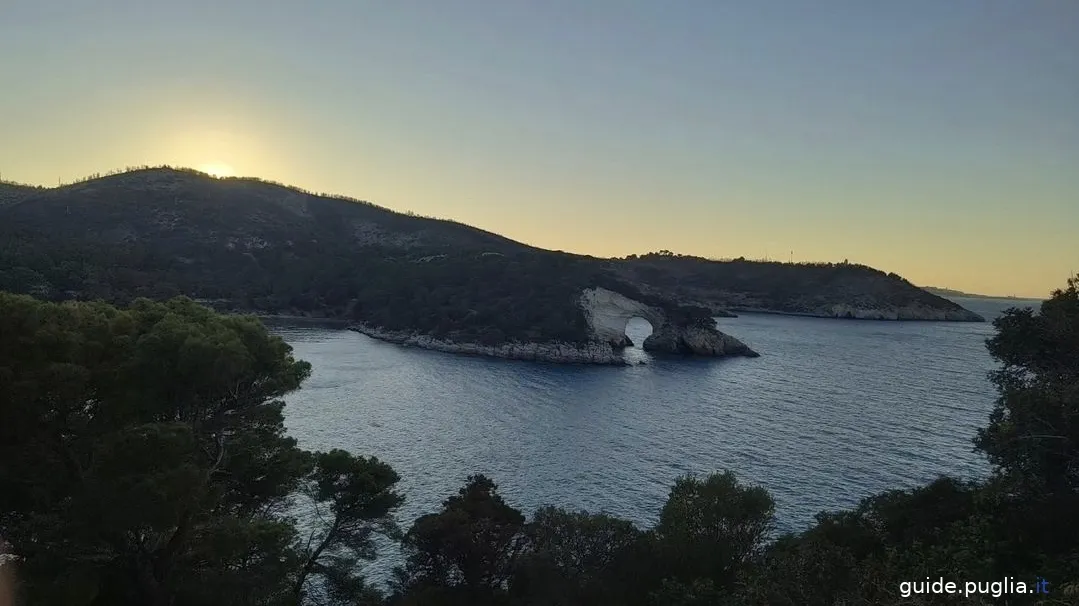
The Arco di San Felice is one of the most spectacular natural wonders on the coast of Vieste, located a few kilometers north of the city. The arch is formed by a limestone rock that, over millennia, has been shaped by natural elements.
The formation creates a natural passage that opens directly onto the Adriatic Sea, with crystal-clear waters making it an ideal place for swimming, snorkeling, and other water activities. The area around the Arco di San Felice hosts various species of plants and animals, some of which are endemic to the Gargano. Conserving these habitats is crucial for maintaining the region's biodiversity.
Accessibility
The Arco di San Felice is easily reachable for those visiting Vieste. It can be accessed on foot via a path starting from the main road or by sea. Its proximity to the city makes it a popular destination for day trips.
Why is it Called Arco di San Felice?
The Arco di San Felice is named because it is located near the locality of San Felice in Vieste. The name "San Felice" could derive from the name of a locally venerated saint or might have been attributed to the area for other historical or cultural reasons related to the local community. In many cases, natural formations like this receive names that reflect local geography, history, or important religious figures in the region.
Pizzomunno
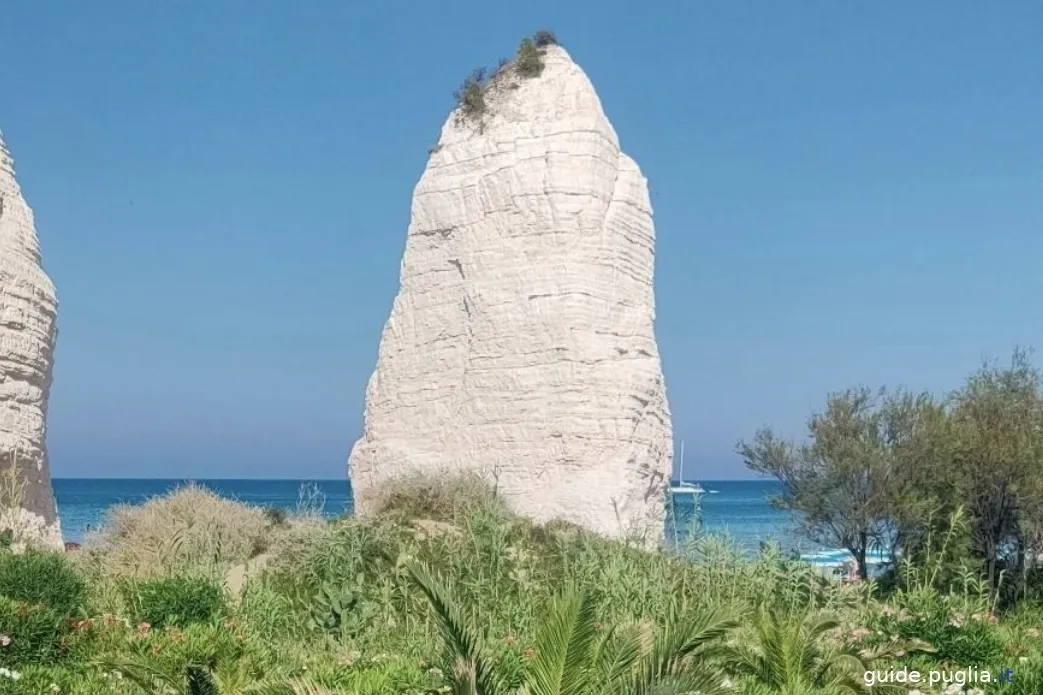
Pizzomunno is an imposing rock formation located on the Spiaggia del Castello in Vieste, in the heart of the Gargano National Park.
This white limestone monolith, about 25 meters high, stands majestically on the Adriatic coast, symbolizing the region's strength and natural beauty. Pizzomunno is a cultural symbol of Vieste, representing themes of faithful love and tragic loss that deeply resonate in local tales.
The Legend of Pizzomunno
The legend of Pizzomunno is one of the most fascinating and romantic stories linked to Vieste. According to tradition, Pizzomunno was a young and strong fisherman, in love with the beautiful Cristalda.
Every day, the sea sirens tried to seduce Pizzomunno with their song, promising him immortality if he abandoned Cristalda and went with them. However, Pizzomunno remained faithful to his love for Cristalda. One day, the sirens, jealous of his devotion, kidnapped Cristalda while she and Pizzomunno were on the beach.
The young woman was dragged into the marine depths, and Pizzomunno, desperate, was turned into stone for eternity, becoming the white monolith that today dominates the beach. According to legend, every hundred years, Cristalda emerges from the waters to briefly reunite with her beloved Pizzomunno.
The legend of Pizzomunno is celebrated in the music and art of the region, making the monolith a tourist destination rich in emotional and historical significance.
The Trabucchi
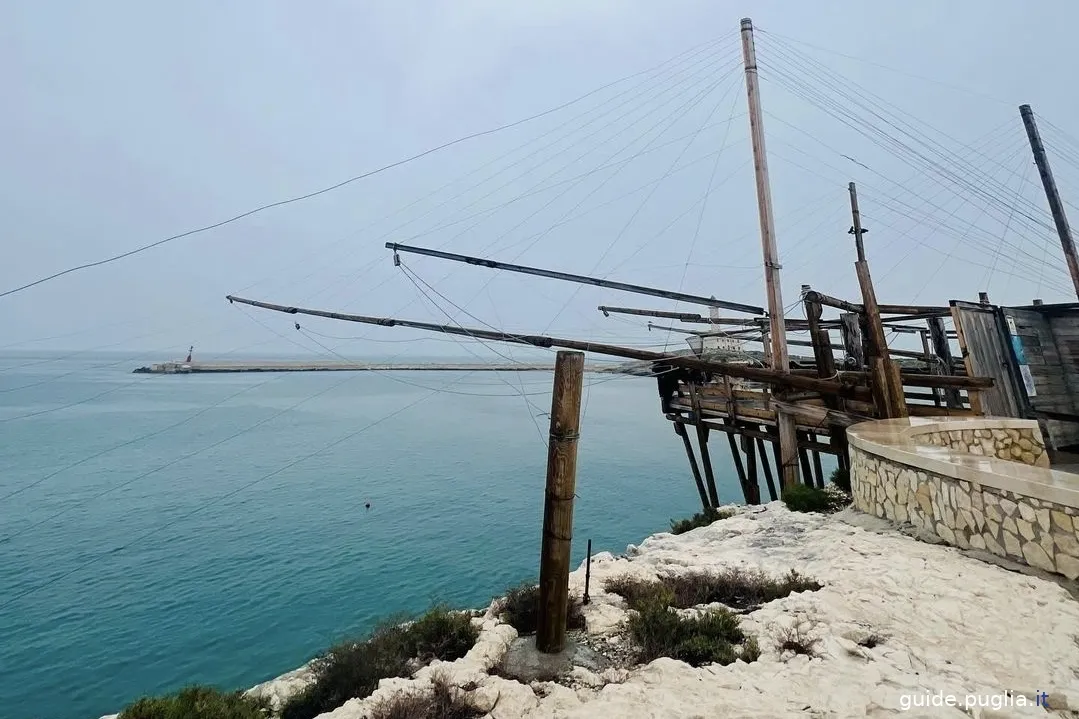
The trabucchi are ancient fishing machines typical of the Gargano coast. These wooden structures are built on rocky platforms and equipped with long arms that support fishing nets.
These fascinating structures are a symbol of the maritime heritage of the region and offer a direct connection to the historical fishing traditions of the area.
Characteristics of the Trabucchi

- Construction: Trabucchi are mainly made from pine and chestnut wood, materials chosen for their resistance to salt and weather conditions. The long arms (or antennas) support the nets, which are lowered and raised to catch fish.
- Operation: The operation of a trabucco is relatively simple yet effective. The nets are lowered into the sea and then raised using a system of winches and pulleys, trapping the fish swimming nearby.
- History and Tradition: Trabucchi have ancient origins and have been used for centuries by local fishermen. Today, many of these trabucchi have been restored and have become tourist attractions, often offering restaurants that serve fresh fish directly on the trabucco platform.
Trabucchi in Vieste
Some of the most well-known trabucchi in Vieste include:
- Trabucco di San Lorenzo: Located near the historic center of Vieste, this trabucco is easily accessible and offers a spectacular view of the coast.
- Trabucco di Punta Lunga: Positioned south of the center of Vieste, it is another well-preserved example of this tradition.
- Trabucco di Molinella: This trabucco is located near Molinella beach and is often visited for its picturesque scenery.
What to Do in Vieste?
Exploring the Sea Caves
Boat excursions from Vieste offer a variety of fascinating itineraries, including the opportunity to visit several sea caves along the Gargano coast, each with unique and captivating features.
Each cave offers a unique experience, and boat tours not only allow visits to them but often include opportunities to swim near the caves or practice snorkeling.
Some tours also offer additional services such as detailed explanations of geological formations and cave history, onboard aperitifs, and snorkeling equipment. Specialized guided tours may include ecological and historical insights, making the experience educational as well as enjoyable.
Here are some of the most popular caves commonly included in tours:
Grotta dei Contrabbandieri
Known for its large internal chambers and crystal-clear waters, it is one of the most adventurous caves to explore.
The name dates back to times when the cave was used by smugglers as a hideout for their illicit goods. The cave is primarily accessible by sea, making it an ideal spot for smugglers looking to evade authorities.
Its spacious chambers and hidden channels provided ample space to stash goods until they could be safely transported ashore under the cover of darkness or favorable weather conditions.
Grotta Sfondata
One of the most spectacular and photographed sea caves on the Gargano coast, located near Vieste.
This cave is particularly known for its unique feature: a large opening, or "sinkhole," in the ceiling that allows sunlight to penetrate deeply into the underlying cavity, creating a magical and luminous environment inside.
The water within Grotta Sfondata is exceptionally clear due to marine currents flowing through the cave, helping to keep the water clean and transparent. This makes the cave an ideal spot for snorkeling and scuba diving, allowing visitors to explore the marine life-rich seabed.
The cave is primarily accessible by sea, with boat tours from Vieste offering the chance to visit this and other caves, accompanied by expert guides who provide detailed explanations about the cave's geological formation and ecology.
Grotta delle Due Occhi
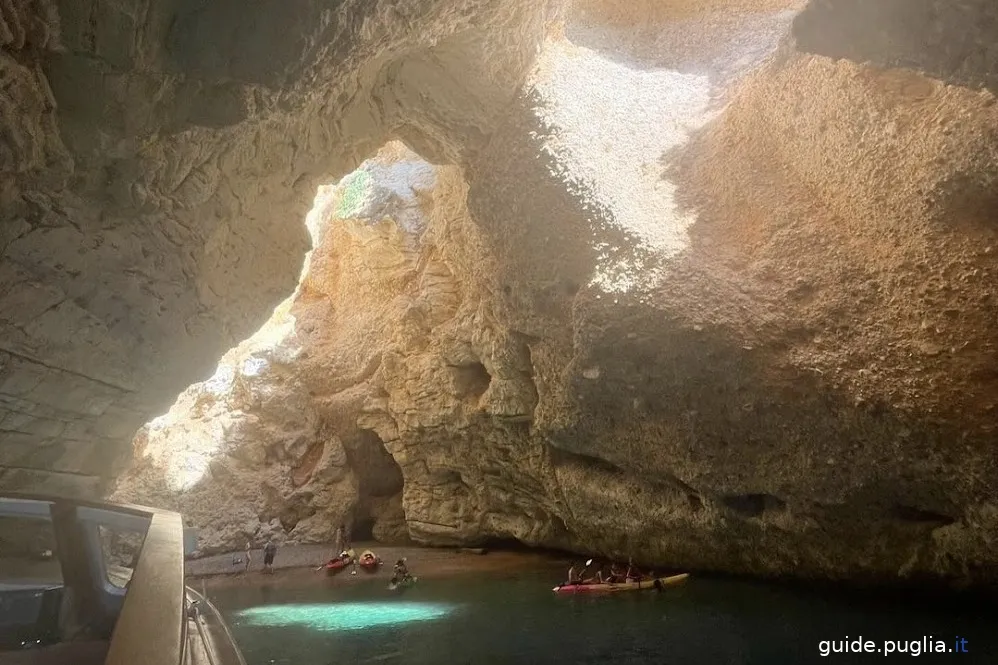
This cave is named for the two large holes in the ceiling that resemble two eyes, illuminating the water below and creating incredible light effects that vary depending on the time of day and weather conditions. The water inside the cave takes on hues ranging from deep blue to turquoise, depending on the intensity and angle of the sunlight.
Grotta del Bue Marino
Named after the monk seals, locally known as "bue marino," that once found refuge in its tranquil waters. Although these seals have disappeared from the area, the cave retains their memory in its name. The Grotta del Bue Marino is famous for its impressive stalactite and stalagmite formations that adorn the cave's ceiling and floor, creating a surreal environment.
Grotta Azzurra
Best known for the incredible blue color of its interior waters, giving the cave its name. This phenomenon is the result of sunlight penetrating the water, reflecting off the sandy bottom, and creating a spectacular visual effect.
Besides its famous blue light, the cave features interesting rock formations, including stalactites and stalagmites that decorate the ceiling and seabed, enriching the natural environment with suggestive shapes and textures. To best experience the blue light effect, it is advisable to visit the cave during the central hours of the day when the sun is high, allowing the light to penetrate more deeply through the cave's openings.
Trekking in the Umbra Forest
The Umbra Forest offers a variety of well-equipped and signposted hiking trails, ideal for different levels of difficulty and interests. With over 100 km of trails, the park has paths ranging from simple nature walks to more challenging treks through dense vegetation, offering breathtaking views.
The trails are clearly marked with trail markers and directional signs, making navigation easy without the need for a guide. However, for those seeking a more in-depth or specific experience, such as night trekking or identifying botanical and wildlife species, participating in guided tours organized by local entities might be beneficial.
For history enthusiasts, there is also the possibility of exploring remnants of the forest's industrial past, such as the old Decauville railway, which once transported timber out of the park.
It is not necessary to book a guide to enjoy the trails, but for those seeking a more educational or thematic experience, guides can greatly enrich the visit.
Excursions to the Tremiti Islands
Excursions to the Tremiti Islands from Vieste offer various options, ranging from group tours to more personalized and relaxing ones, allowing the discovery of the natural and cultural beauties of the archipelago.
- Economy Tour: This is the most accessible and popular group tour, lasting about 90 minutes plus a short swimming stop. During this tour, you can admire the coast of San Domino, the architiello of San Domino, and various points of interest such as the Grotta delle Rondinelle and Cala degli Inglesi. This type of tour is ideal for those seeking a quick and economical experience.
- Super Relax Mini Cruise: This option offers a three-hour experience aboard a dinghy, allowing more intimate access to coves and caves, with various stops for swimming or snorkeling. It is perfect for small groups or families looking for a quieter and more personalized experience, away from the crowds.
- Custom Excursions: For those desiring a tailored experience, custom tours are available that adapt to individual preferences. These tours can vary in duration and itinerary, offering a more exclusive and detailed service, ideal for thoroughly exploring the Tremiti Islands in the company of expert skippers who share anecdotes and curiosities about the place.
During these excursions, you will have the opportunity to explore the numerous caves of the archipelago, including the Grotta delle Viole and the Grotta del Bue Marino, and admire the underwater statue of Padre Pio.
It is advisable to bring a packed lunch to avoid long lines at the few bars and restaurants available on the island, especially during the high season.
Photography and Birdwatching
The Umbra Forest is a perfect place to photograph endemic plant and animal species. The cliffs and beaches along the coast offer spectacular panoramic views for landscape photography, as well as being habitats for numerous species of seabirds.
Additionally, there are several historical towers that can be used as elevated observation points for photography and birdwatching:
- Torre Gattarella: Located within the namesake resort, this tower offers a panoramic view of the sea and surrounding landscapes.
- Torre di Portonuovo and Torre di San Felice: Both offer spectacular views and are accessible to visitors, allowing for bird observation in a natural elevated and wide-ranging context.
The towers not only enrich the visual experience but also provide an elevated vantage point for observing birds without disturbing them, especially during feeding or resting hours.
Moreover, there are various wetlands and salt pans that attract migratory and resident birds. These environments are ideal for birdwatching, especially during migration periods.
When to Visit Vieste?
Vieste is charming in every season, but the best time to visit depends on what you want to do:
- Summer (June - August): Summer is the peak tourist season in Vieste, with warm and sunny weather ideal for enjoying the beaches, swimming, and a variety of water sports. The city is lively with numerous cultural events, festivals, and a vibrant nightlife. However, it is also the most crowded period, so it may be necessary to book accommodations and restaurants in advance.
- Spring (March - May): Spring is a great time to visit Vieste if you prefer to avoid the high season crowds. The weather is pleasantly warm, and nature is in full bloom, making this period ideal for hiking, cycling, and exploring the Gargano National Park. Easter holidays and other local events add further charm to the visit.
- Autumn (September - November): Autumn in Vieste still offers pleasant temperatures and fewer tourists. It is an excellent time for those seeking a relaxing vacation with the possibility of still enjoying the sea and beaches. Hiking and cultural visits are particularly pleasant thanks to the mild climate.
- Winter (December - February): Winter is quiet and less touristy, ideal for those wishing to explore the city without the summer crowds. Although the weather is cooler and some attractions may be closed, Vieste still has much to offer, such as the serene beauty of its coasts and the chance to participate in traditional winter festivities.
Conclusion
Vieste is a shining gem of the Gargano, enchanting visitors with its spectacular monolith of Pizzomunno, romantic legends, and breathtaking coasts.
The city offers a perfect combination of natural beauty, historical richness, and adventure opportunities, from discovering the sea caves to exploring the lush Umbra Forest. Its fine sandy beaches and crystal-clear waters invite relaxation and contemplation, while the vibrant historic center and various cultural events enrich every visitor's experience.
Vieste, with its unique atmosphere and diverse attractions, is a destination that promises to leave a lasting impression.
